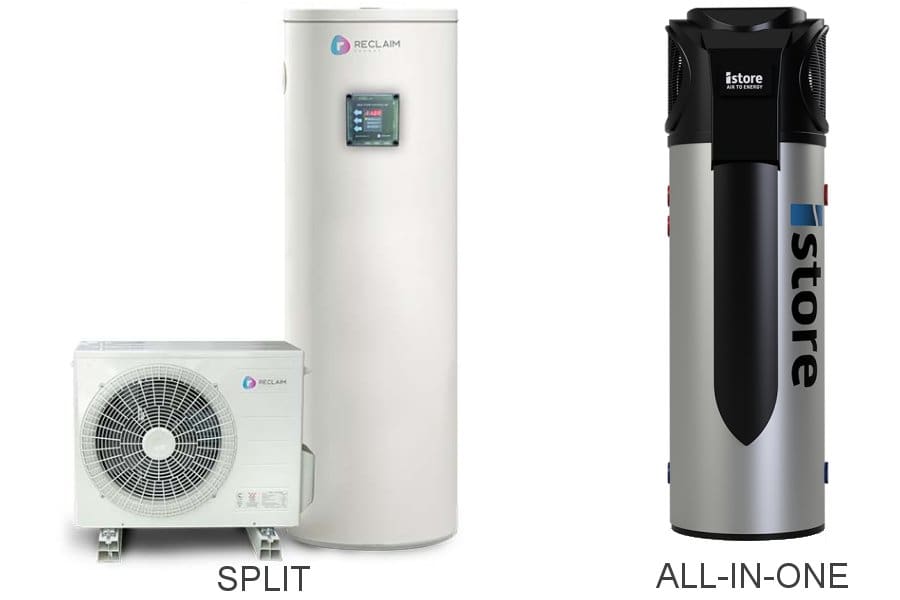If you’re curious about heat pump hot water systems and want an introduction to the technology, here’s the perfect place to start. Discover how these systems work and the different types available, efficiency, costs, solar integration, and more.
If you’re looking to learn *everything* you need to know about how they work and choosing a system, then SolarQuotes founder Finn Peacock’s comprehensive guide to hot water heat pumps is for you. But if you’re just heat-pump-curious or want the nuts and bolts so speak, then the video above and this explainer cover the essentials.
All-In-One Vs Split Units
Hot water heat pumps are available in two forms – split systems where the compressor unit and tank are separate, and all-in-one (aka AIO or integrated) units where the compressor and such are integrated on top of the tank. Split systems tend to have slightly better efficiency, water heating rates and noise levels, while all-in-one units have a smaller footprint, less external pipework, are easier to install and are often cheaper than split systems.


How Hot Water Heat Pumps Work
A heat pump hot water system takes heat out of the air and transfers it into the water.
A fan draws air into the unit over an evaporator coil. Heat from the air turns liquid refrigerant into a gas. The liquid refrigerants used have a very low boiling point – for example, carbon dioxide’s (R744) boiling point at 0.5 MPa is -25°C. Another example refrigerant is propane (R290), which has a boiling point of -10C.
The gas is then pumped at high pressure through a valve by a compressor further increasing its heat, while cool air exits the heat pump. A condenser coil transfers heat to the water. As the refrigerant cools and mostly condenses back into a liquid, it’s cooled further after flowing through expansion valve and the process starts again. Thermostats and other controls regulate the heat pump’s operation.
Hot water heat pumps store water at least 60°C to prevent Legionella bacteria growing, but deliver it below 50°C to prevent scalding – this is handled by a mixing valve.
Hot water heat pumps are generally pretty quiet in their operation: 37–55 decibels; which is quiet fan to fridge territory.
Efficiency/Energy Use
Heating water is one of the most energy-intensive activities in our homes.
A conventional electric resistive hot water system has an efficiency of around 100%. While the real-world efficiency of really crappy hot water heat pumps is also close to 100%, good budget units can have average efficiency of 350% to 400%, and the top-end models up to a claimed 500%.
Basically, for every unit of electrical energy, good hot water heat pumps can amplify this up to five times in heating energy. This amplification is known as “Coefficient of Performance” – or COP. For example, a unit with 350% efficiency will have a COP of 3.5.
Given Australia’s conditions, using a hot water heat pump basically anywhere south of Brisbane is hands down the most efficient way to heat water. They move heat rather than creating it, consuming way less energy than a conventional hot water system using an element. But some heat pumps also include a backup element in case you’re caught short.
Integrating With Solar Power
A heat pump’s low power draw of around 500 – 1,000 watts means they are perfect to use with solar power systems. It’s a great way to make use of surplus solar energy instead of exporting it to the grid for what has increasingly become a pittance in terms of feed-in tariffs. Consider a hot water heat pump as a battery of sorts.
Many heat pumps will come with a timer, which is useful for setting the “solar window” and/or avoiding periods when grid electricity is at its most expensive. And that leads on to an important point – minimising mains electricity use when it isn’t being powered from your panels. How little it uses isn’t just down to your solar panels and the quality of the system, but also installation quality.
A good hot water heat pump system installation not only features a well- insulated tank, but the hot water pipes including elbows, valves and the first 300mm of drain should be insulated with good quality UV-stabilised material.
Costs And Rebates
Prices for heat pumps can vary wildly, but a general rule of thumb is sub-$2,000 models are noisy, inefficient, use nasty refrigerants and are often unreliable. At the other end of the scale are units costing $5,000. Some of these may be worth the money, but others not so; and we’ll get to recommended brands in a bit.
Whether you opt for a budget or high-end unit, the good news is there are financial incentives available to bring down the cost of buying and installing a system.
One of those incentives are Small-scale Technology Certificates (STCs), usually offered as an up-front discount and available nationally. Depending on the unit and several other factors, they can knock about $750 off the price. In addition to STC’s, some states have their own incentive programs – including Victoria (up to $1,200 off), New South Wales (up to $670), South Australia (up to $850) and the ACT (ACTEW AGL up to $1,250 + $250 credit).
STC subsidies and other incentives are further explained in Finn’s full guide.
Maintenance And Warranty
Hot water heat pumps are relatively maintenance free – but all glass lined tanks have sacrificial anodes that will need to be replaced every 3 to 5 years depending on the manufacturer’s instructions. Failing to do so can void the warranty.
Just on warranty, don’t settle for less than 5 years on the heat pump bits and 10 years on the tank – and check warranty details carefully for any gotchas or additional maintenance required.
Recommended Hot Water Heat Pump Brands
Like solar panels, inverters, home batteries and electric cars, we’re spoiled for choice for heat pumps in Australia. And too much choice can lead to confusion.
Navigating datasheets, technobabble and manufacturer claims can be a time-sucking exercise. If you’d like a short-cut through all that, check out the SolarQuotes recommended heat pump brands chart listing manufacturers from budget through to high end that Finn would currently recommend to a friend.
But remember, even the best gear can be ruined by lousy installation!
If this explainer and the video above has left you wanting more information, read Finn’s full hot water heat pump guide here. It also includes a comparison table of models available in Australia along with estimated pricing of each.






